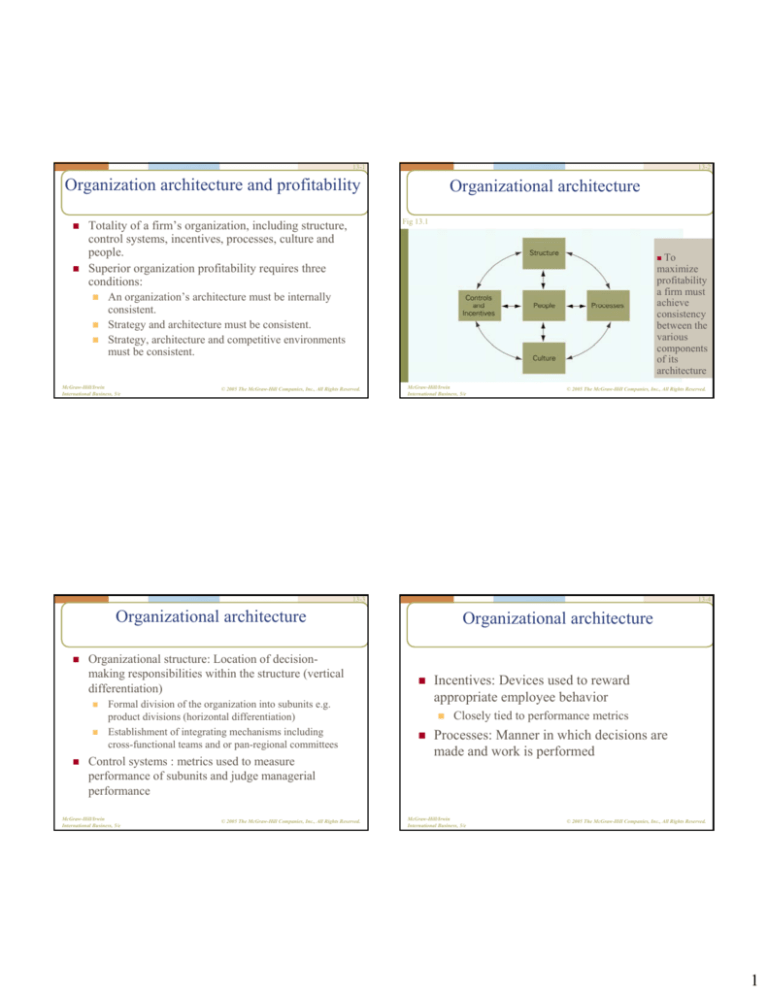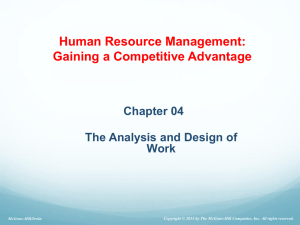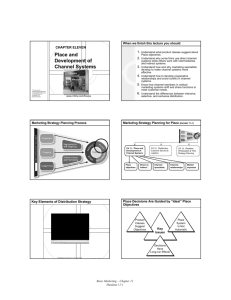
13-1
13-2
Organization architecture and profitability
Fig 13.1
Totality of a firm’s organization, including structure,
control systems, incentives, processes, culture and
people.
Superior organization profitability requires three
conditions:
Organizational architecture
To
maximize
profitability
a firm must
achieve
consistency
between the
various
components
of its
architecture
An organization’s architecture must be internally
consistent.
Strategy and architecture must be consistent.
Strategy, architecture and competitive environments
must be consistent.
McGraw-Hill/Irwin
International Business, 5/e
© 2005 The McGraw-Hill Companies, Inc., All Rights Reserved.
McGraw-Hill/Irwin
International Business, 5/e
© 2005 The McGraw-Hill Companies, Inc., All Rights Reserved.
13-3
13-4
Organizational architecture
Organizational structure: Location of decisionmaking responsibilities within the structure (vertical
differentiation)
Formal division of the organization into subunits e.g.
product divisions (horizontal differentiation)
Establishment of integrating mechanisms including
cross-functional teams and or pan-regional committees
Control systems : metrics used to measure
performance of subunits and judge managerial
performance
McGraw-Hill/Irwin
International Business, 5/e
© 2005 The McGraw-Hill Companies, Inc., All Rights Reserved.
Organizational architecture
Incentives: Devices used to reward
appropriate employee behavior
Closely tied to performance metrics
Processes: Manner in which decisions are
made and work is performed
McGraw-Hill/Irwin
International Business, 5/e
© 2005 The McGraw-Hill Companies, Inc., All Rights Reserved.
1
13-5
Organizational architecture
13-6
Purpose of Organizational Structure
Organizational culture: Values and norms
shared among employees of an organization
Strategy used to manage human resources
People: Employees
Strategy used to recruit, compensate, and retain
individuals with necessary skills, values and
orientation
McGraw-Hill/Irwin
International Business, 5/e
© 2005 The McGraw-Hill Companies, Inc., All Rights Reserved.
to exercise control
to establish division of labor
to facilitate communications
to facilitate coordination & integration
to establish accountability
to delegate responsibility
to establish lines of authority and chain of
command
to establish rules and regulations
McGraw-Hill/Irwin
International Business, 5/e
© 2005 The McGraw-Hill Companies, Inc., All Rights Reserved.
13-7
Vertical differentiation
Concerned with
where decisions are
made
Where is decision
making power
concentrated?
13-8
Key Dimensions of Organizational
Structure
Specialization
Standardization
Centralization
Two Approaches
Centralization
Decentralization
McGraw-Hill/Irwin
International Business, 5/e
© 2005 The McGraw-Hill Companies, Inc., All Rights Reserved.
McGraw-Hill/Irwin
International Business, 5/e
© 2005 The McGraw-Hill Companies, Inc., All Rights Reserved.
2
13-9
13-10
Strategy and organization structure
Vertical differentiation
Major strategic decisions are centralized at the firm’s
headquarters while operating decisions are decentralized
Concerned with where decisions are made.
Centralization:
Facilitates coordination.
Ensure decisions
consistent with
organization’s
objectives.
Top-level managers have
means to bring about
organizational change.
Avoids duplication of
activities.
McGraw-Hill/Irwin
International Business, 5/e
Decentralization:
Overburdened top
management.
Motivational research
favors decentralization.
Permits greater
flexibility.
Can result in better
decisions.
Can increase control.
© 2005 The McGraw-Hill Companies, Inc., All Rights Reserved.
Global strategy : aim to
realize location and
experience economies
Centralization of some
operating decisions
Multi-domestic firms: aim
for local responsiveness
Decentralizing operating
decisions to foreign
subsidiaries
McGraw-Hill/Irwin
International Business, 5/e
International firms: maintain
centralized control over
their core competency and
decentralize other decision
to foreign subsidiaries
Transnational firms: aim to
realize location and
experience curve economies
Centralized control over
global production centers
Need to be locally
responsive
© 2005 The McGraw-Hill Companies, Inc., All Rights Reserved.
13-11
Structure of the domestic firm
13-12
The functional structure
Concerned with structure design
Decisions made on basis of function, type of
business or geographical area
Structure of domestic firms
Typically, the structure
that evolves in a
company’s early stages.
Single entrepreneur or small team of individuals
therefore a centralized structure
With introduction of more product lines, product
divisional structure introduced
Each division responsible for single product line
Self-contained, largely autonomous entities
Responsible for operating decisions and
performance
McGraw-Hill/Irwin
International Business, 5/e
© 2005 The McGraw-Hill Companies, Inc., All Rights Reserved.
Coordination and
control rests with
top management.
McGraw-Hill/Irwin
International Business, 5/e
© 2005 The McGraw-Hill Companies, Inc., All Rights Reserved.
3
13-13
A typical functional structure
13-14
Product division structure
Fig 13.3
Probable next stage of
development. Reflects
company growth into
new products.
Each unit responsible
for a product.
Semiautonomous and
accountable for
its performance.
Eases coordination
and control
problems.
McGraw-Hill/Irwin
International Business, 5/e
© 2005 The McGraw-Hill Companies, Inc., All Rights Reserved.
McGraw-Hill/Irwin
International Business, 5/e
© 2005 The McGraw-Hill Companies, Inc., All Rights Reserved.
13-15
13-16
A typical product divisional structure
International division
Fig 13.4
Widely used.
1. Can create conflict
between domestic and
foreign operations.
2. Implied lack of
coordination between
domestic and foreign
operations.
Growth can lead
to worldwide
structure.
McGraw-Hill/Irwin
International Business, 5/e
© 2005 The McGraw-Hill Companies, Inc., All Rights Reserved.
McGraw-Hill/Irwin
International Business, 5/e
© 2005 The McGraw-Hill Companies, Inc., All Rights Reserved.
4
13-17
One Company’s international division
structure
13-18
International Division Structure
Fig 13.5
McGraw-Hill/Irwin
International Business, 5/e
© 2005 The McGraw-Hill Companies, Inc., All Rights Reserved.
adopted in early stages of international
business operations
coordinate all IB activities
develop international expertise & skills
develop a global/international mindset
champion of foreign business
McGraw-Hill/Irwin
International Business, 5/e
© 2005 The McGraw-Hill Companies, Inc., All Rights Reserved.
13-19
Disadvantages of Intl. Division
dependent on domestic product divisions for
R&D, engg., etc.
conflict over pricing and transfer pricing
power struggles in firm: intl Vs. domestic
cannot handle too many products
not appropriate if foreign sales over 25%
13-20
Worldwide area structure
Favored by firms with
low degree of
diversification.
Area is usually
a country. Largely
autonomous.
Facilitates local
responsiveness.
heads of foreign subsidiaries relegated to
second-tier positions
McGraw-Hill/Irwin
International Business, 5/e
© 2005 The McGraw-Hill Companies, Inc., All Rights Reserved.
McGraw-Hill/Irwin
International Business, 5/e
© 2005 The McGraw-Hill Companies, Inc., All Rights Reserved.
5
13-21
13-22
Worldwide area structure
A worldwide area structure
Worldwide area structure
Fig 13.7
Favored by firms with low degree of
diversification & domestic structure based on
function
World is divided into autonomous geographic
areas
Operational authority decentralized
Facilitates local responsiveness
Fragmentation of organization can occur
Consistent with multidomestic strategy
McGraw-Hill/Irwin
International Business, 5/e
© 2005 The McGraw-Hill Companies, Inc., All Rights Reserved.
McGraw-Hill/Irwin
International Business, 5/e
© 2005 The McGraw-Hill Companies, Inc., All Rights Reserved.
13-23
13-24
World wide product divisional
structure
Product division
Reasonably
diversified firms.
Attempts to overcome
international division
and worldwide area
structure problems.
Weak local
responsiveness.
McGraw-Hill/Irwin
International Business, 5/e
Believe that product value
creation activities should
be coordinated
worldwide.
© 2005 The McGraw-Hill Companies, Inc., All Rights Reserved.
Adopted by firms that are reasonably diversified
Original domestic firm structure based on product
division
Value creation activities of each product division
coordinated by that division worldwide
Help realize location and experience curve economies
Facilitate transfer of core competencies
Problem: area managers have limited control,
subservient to product division managers, leading to lack
of local responsiveness
McGraw-Hill/Irwin
International Business, 5/e
© 2005 The McGraw-Hill Companies, Inc., All Rights Reserved.
6
13-25
13-26
A worldwide product division structure
Matrix structure
Fig 13.8
Attempts to meet needs
of transnational
strategy.
Doesn’t work as well
as theory predicts.
Conflict and
power struggles.
McGraw-Hill/Irwin
International Business, 5/e
© 2005 The McGraw-Hill Companies, Inc., All Rights Reserved.
McGraw-Hill/Irwin
International Business, 5/e
“Flexible” matrix
structures.
© 2005 The McGraw-Hill Companies, Inc., All Rights Reserved.
13-27
13-28
Horizontal differentiation: Global
matrix structure
Helps to cope with conflicting demands of earlier
strategies
Two dimensions: product division and geographic
area
Product division and geographic areas given equal
responsibility for operating decisions
Problems
A Global matrix structure
Fig 13.9
Bureaucratic structure slows decision making
Conflict between areas and product divisions
Difficult to make one party accountable due to dual
responsibility
McGraw-Hill/Irwin
International Business, 5/e
© 2005 The McGraw-Hill Companies, Inc., All Rights Reserved.
McGraw-Hill/Irwin
International Business, 5/e
© 2005 The McGraw-Hill Companies, Inc., All Rights Reserved.
7
13-29
13-30
The International structural stages
model
Integrating mechanisms
Fig 13.6
Need for coordination follows the following order
on an ascending basis
High
Transnational
Multi domestic corporations
International companies
Global companies
Low
McGraw-Hill/Irwin
International Business, 5/e
© 2005 The McGraw-Hill Companies, Inc., All Rights Reserved.
McGraw-Hill/Irwin
International Business, 5/e
© 2005 The McGraw-Hill Companies, Inc., All Rights Reserved.
13-31
13-32
Integrating mechanism
Formal integrating mechanisms
Fig 13.10
Impediments to coordination
Differing goals and lack of respect
Different orientations due to different tasks
Differences in nationality, time zone & distance
Particularly problematic in multinational
enterprises with its many subunits both home
and abroad
McGraw-Hill/Irwin
International Business, 5/e
© 2005 The McGraw-Hill Companies, Inc., All Rights Reserved.
McGraw-Hill/Irwin
International Business, 5/e
© 2005 The McGraw-Hill Companies, Inc., All Rights Reserved.
8
13-33
13-34
Formal integrating systems
Informal integrating mechanisms
Direct contact between subunit managers
Liaison roles: an individual assigned
responsibility to coordinate with another
subunit on a regular basis
Temporary or permanent teams from subunits
to achieve coordination
Matrix structure: all roles viewed as
integrating roles
Informal management networks supported by
an organization culture that values teamwork
and a common culture
Non-bureaucratic flow of information
It must embrace as many managers as possible
Two techniques used to establish networks
Often based on geographical areas and
worldwide product divisions
McGraw-Hill/Irwin
International Business, 5/e
Information systems
Management development policies
© 2005 The McGraw-Hill Companies, Inc., All Rights Reserved.
Rotating managers through various subunits on a
regular basis
McGraw-Hill/Irwin
International Business, 5/e
© 2005 The McGraw-Hill Companies, Inc., All Rights Reserved.
13-35
13-36
Control systems & incentives
Types of control systems
Personal controls
Bureaucratic controls
Output controls
Cultural controls
Seniority and nature of work
© 2005 The McGraw-Hill Companies, Inc., All Rights Reserved.
Reward linked to output target that the employee
can influence
Cooperation between managers in subunits
Refer to devices used to reward appropriate
behavior
Closely tied to performance metrics used for
output controls
McGraw-Hill/Irwin
International Business, 5/e
Incentive systems
Factors influencing incentive system
Link incentives to profit of the entire firm
National differences in institutions and culture
Consequences of an incentive system should
be understood
McGraw-Hill/Irwin
International Business, 5/e
© 2005 The McGraw-Hill Companies, Inc., All Rights Reserved.
9
13-37
Performance ambiguity
13-38
Strategy, interdependence and ambiguity
Key to understanding the relationship between
international strategy, control systems and incentive
systems
Caused due to high degree of interdependence
between subunits within the organization
A function of the
interdependence among
subunits.
McGraw-Hill/Irwin
International Business, 5/e
Level of performance ambiguity depends on
number of subunits, level of integration & joint
decision making
Ascending order of ambiguity in firms
High
Control Systems
Multinational
Output/Bureaucratic
Transnational
companies (highest
companies
International companies
Multi domestic corporations
Global
Global/Transnational
Cultural
Low
© 2005 The McGraw-Hill Companies, Inc., All Rights Reserved.
McGraw-Hill/Irwin
International Business, 5/e
© 2005 The McGraw-Hill Companies, Inc., All Rights Reserved.
13-39
Costs of control for the four
International business strategies
13-40
Implications for control and incentives
Costs of control:
McGraw-Hill/Irwin
International Business, 5/e
© 2005 The McGraw-Hill Companies, Inc., All Rights Reserved.
Time top mgt. must devote to monitoring and
evaluating subunits performance
Performance ambiguity increases cost of control
Creates conflicts as the costs of controlling
transnational strategy are much higher
Cultural controls
Incentive pay of senior managers should be linked to
the entity to which both subunits belong
McGraw-Hill/Irwin
International Business, 5/e
© 2005 The McGraw-Hill Companies, Inc., All Rights Reserved.
10
13-41
13-42
Processes
Organizational culture
Manner in which decisions are made and
work is performed
Values and norms shared among people
Sources:
Cut across national boundaries as well as
organizational boundaries
Can be developed anywhere within the firms global
operations network
Cultural maintenance:
McGraw-Hill/Irwin
International Business, 5/e
© 2005 The McGraw-Hill Companies, Inc., All Rights Reserved.
Founders and important leaders
National social culture
History of the enterprise
Decisions that result in high performance
Hiring and promotional practices
Reward strategies
Socialization processes
Communication strategy
McGraw-Hill/Irwin
International Business, 5/e
© 2005 The McGraw-Hill Companies, Inc., All Rights Reserved.
13-43
Synthesis of strategy, structure and control
systems
13-44
Organization culture and performance
A “Strong” Culture:
Adaptive cultures.
Culture must match an
organization’s architecture
Culture does not
necessarily translate across
borders
McGraw-Hill/Irwin
International Business, 5/e
© 2005 The McGraw-Hill Companies, Inc., All Rights Reserved.
McGraw-Hill/Irwin
International Business, 5/e
Transnational
Strong
Culture
Not always good
Sometimes beneficial,
sometimes not
Context is important
Weak
Global
International
Multidomestic
© 2005 The McGraw-Hill Companies, Inc., All Rights Reserved.
11
13-45
13-46
Organizational change
Firms need to periodically alter their architecture to
conform to changes in environment & strategy
Hard to achieve due to organizational inertia
Sources of inertia
Possible redistribution of power and influence
among managers
Strong existing culture
Senior manager’s preconceptions about the
appropriate business model
Institutional constraints such as national regulations
including local content rules regarding layoffs
Organizational change
Change to match competitive and strategy
environment
Existing distribution of power and influence.
Current culture.
Manager’s preconceptions about the appropriate
business model or paradigm.
Institutional constraints.
Principles for change;
McGraw-Hill/Irwin
International Business, 5/e
© 2005 The McGraw-Hill Companies, Inc., All Rights Reserved.
Hard to change:
Unfreeze the organization.
Moving to the new state.
Refreezing the organization.
McGraw-Hill/Irwin
International Business, 5/e
© 2005 The McGraw-Hill Companies, Inc., All Rights Reserved.
12









